BY KIRK McKINZIE AND STEFAN TRUTHÄN
Our world is in a state of perpetual change, presenting us with an ever-growing array of challenges, from shifting weather trends to digitization to urban-specific concerns like densification and competition for space. Emergency services face increasingly volatile situations in which traditional strategies are losing their efficacy.
- The Future of Artificial Intelligence in Firefighting
- How the Cosumnes Fire Department Incorporates Virtual Reality into Its Fire Academy Training
- Working Harder and SMARTer Through Next-Generation Technology
We have entered an era where faster and more efficient SMART systems (electronic systems that collect data through sensors, process the data, and take desired actions) are supplanting traditional technologies. How can firefighters transform strategic thinking and actions from reactive to proactive? It is critical to discuss and identify sustainable solutions for public safety. The complexity of the VUCA (Volatile, Uncertain, Complex, and Ambiguous) world is challenging to convey, but deconstruction will allow us to examine individual elements more closely and understand their interactions (Figure 1).
Figure 1. VUCA: Volatile, Uncertain, Complex, and Ambiguous

The problem is not that public safety needs a new compass. It is that the traditional compass needs help to find the true north; like the magnetic pole, it constantly shifts in the VUCA world. The future of public safety will require an agile and evergreen approach. (Source: Figure courtesy of authors.)
Is it time to scrutinize public safety’s fundamental building blocks and identify why established components—be they rules, laws, or work methodologies—need updating to keep pace with digital transformation, new work models, diversity, and SMART community risk reduction? A shift has begun, and further discussion is necessary to ensure the holistic evolution of public safety mechanisms for a safer planet.
Leaders now demonstrate how the digital twin of public safety, using building information modeling (BIM) and geographic information system (GIS) data, can support SMART city initiatives and shape the future of public safety in urban environments. It is possible to explore how digital urban and architectural models can be leveraged to anticipate and simulate emergency and crisis scenarios. The aim is to equip rank-and-file and senior staff with the knowledge and tools necessary to proactively develop sustainable public safety strategies in our increasingly digitized and interconnected world.
Topics for Moving Forward
Contemplating the path ahead in our journey toward safer, more intelligent, and more resilient communities will take a community effort. It will require a vast pool of well-founded concepts with teams working in a coordinated manner. Below are some ideas coming to bear in the industry. These ideas are expected to prove vital for the connected apparatus, fire, rescue, and emergency medical systems (EMS) stations and services of the future.
- Advanced technology integration. Future fire and rescue stations will likely rely heavily on advanced technologies. This could include using drones for aerial reconnaissance; virtual reality (VR), like FLAIM Systems, for training and simulation; and augmented reality (AR), like C-THRU, powered by Qwake Technologies. The public safety genre must quickly shift to accept AI-driven analytics for predictive risk mitigation and IoT (Internet of Things) sensors to monitor equipment and gather data on incidents in real time.
- Weather trends adaptation. With the increasing impact of severe weather trends, fire and rescue stations must be well-prepared for more frequent and severe natural disasters such as wildfires, hurricanes, and floods. This may involve specialized training, equipment, and strategies to respond effectively to these events.
- Community engagement and education. Fire and rescue stations will likely play a more prominent role in community education and engagement. This could involve proactive measures to educate the public about fire safety, disaster preparedness, and how to mitigate risks in their homes and communities.
- Sustainability and environmental concerns. Fire and rescue stations may need to adopt more sustainable practices, including green building designs, energy-efficient equipment, and ecofriendly firefighting foams. Additionally, they may be increasingly involved in responding to environmental emergencies such as hazardous material spills or chemical incidents.
- Public health integration. The integration of fire and rescue services with public health agencies may become more important, especially in response to pandemics and other public health crises. Fire stations could serve as vaccination centers, testing sites, or part of the emergency response infrastructure during health emergencies.
- Advanced communication and connectivity. Tactical vehicles will be equipped with advanced communication systems that provide seamless connectivity to the station and other emergency services. These systems may include satellite communication, high-speed data networks, broadband, network splicing, and interoperable radio systems with mission-critical push-to-talk (MCPTT) SMART phones to ensure effective coordination during incidents.
- Integrated IoT sensors. These vehicles will feature integrated IoT sensors to monitor their status and surroundings in real time. Sensors can track engine health, equipment readiness, environmental conditions, and even the well-being of personnel inside the vehicle, sending critical data back to the station for analysis and decision making.
- Autonomous capabilities. Autonomous technology may be integrated into tactical vehicles, allowing them to operate semi-autonomously or autonomously in specific situations. For example, they could be programmed to follow a predefined path to reach an incident scene, navigate through hazardous environments, or even deploy remotely operated equipment such as drones or robotic devices.
- Advanced safety features. Future tactical vehicles will prioritize the safety of onboard personnel and first responders. They may include advanced collision-avoidance systems, self-sealing tires, and enhanced vehicle stabilization technology to ensure safe operation in challenging conditions such as offroad terrains or disaster-stricken areas.
- Modular design for multipurpose use. Tactical vehicles will likely feature modular designs, allowing quick customization to suit different mission profiles. This adaptability will enable them to serve a wide range of functions, from fire suppression and rescue operations to medical support and hazardous materials handling, depending on the needs of an incident. These advancements in tactical vehicle technology will enhance the capabilities of fire and rescue stations, enabling them to respond more effectively to emergencies and provide better support to their communities.
First Steps: Location, Location, Location
The rapid advancement of technology is creating a digital debt for public safety agencies, who struggle to keep up. Recently, more than 100 first responders, research facilities, technology enthusiasts, and startups gathered to take steps to pay down that “debt” and move forward with a high-yield dividend-paying SMART future. The October 2023 event encouraged a week of hands-on trials and initiated conversations about what technological advances are needed in the public safety domain.
At the very least, the concept of determining the locations of first responders who have had to call a Mayday is under consideration, with a key focus on ensuring that the incident commander knows their whereabouts. Indiana University organized the weeklong event, which was funded with an initial $8 million from the National Institute of Standards and Technology Public Safety Communications Research team. The challenge was hosted by Indiana University. Twenty-five teams competed; only the final six teams were invited to the Phase 5 finals.
Conducted at the 1,000-acre Muscatatuck Urban Training Center in Indiana, competitors used a variety of technologies, including inertial measurement units (IMU), structured light sensing, and simultaneous location area mapping (SLAIM), to track responder actors in signal-denied environments in an attempt to take home the first-place prize and significant funding aimed at the commercialization of their solutions. The teams transmitted tens of thousands of JavaScript Object Notation (JSON) data packages to the local servers, allowing visualization via active challenge teams’ dashboards (photos 1 and 2).
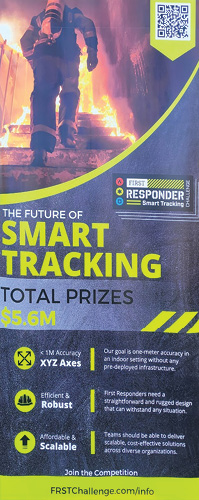
1. The First Responder SMART Tracking Challenge, conducted by Indiana University and funded by the National Institute of Standards and Technology Public Safety Communications Research Division, started with 25 competing teams with a goal of first responder location accuracy of 1 meter in x, y, and z axes. (Photos by authors.)
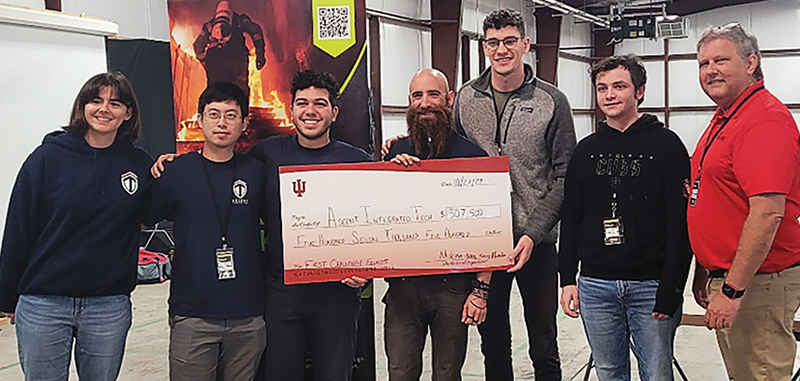
2. Ascent Integrated Technologies (AIT) is one of six teams that took home funds for their efforts. AIT secured an “Excellent” rating and earned more than $500,000 to enable a route to commercialize the first responder location system.
Previous NIST CHARIoT Challenge and CommanDING Tech awardees ingested the JSON data and rendered it live in 3D and augmented reality. On the event’s final day, teams gathered and were issued additional funding, which provided more than $1 million across the final six teams. The event culminated a yearlong effort to plan for, fund, and trial first responder locations in the x, y, and z axes (Figure 2).
Figure 2. First Responders’ Locations in an AR Unity Gaming Engine Application
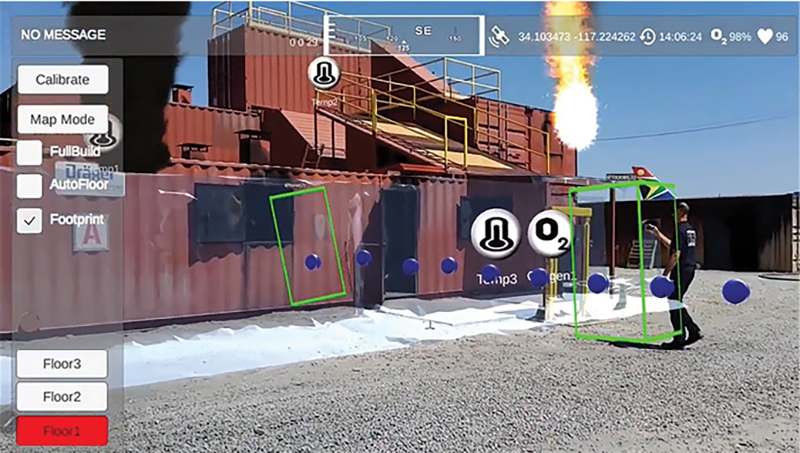
The Emergency Response Information System (ERIS powered by ARCortex) allows for live ingestion of first responders’ locations in augmented reality (AR) Unity gaming engine application for enhanced command and control training and operations. (Source: Figure courtesy of authors.)
Emergency Response Services: Digital Transformation for the Buildings and Workforce of the Future
Internationally, the digital transformation of fire stations and emergency response structures (both hard and soft) continues accelerating. Everyone involved in this critical work, from the newest first responder to the commissioner, focuses on advancing information systems attempting to close the digital and technical debt. They must consider risk management, cyber and data security, cloud services, biometric access management, internal and external customer relations, ethical AI, and effective lifesaving responses. One emerging technology that has the potential to revolutionize emergency response is digital twins.
Digital twins provide stakeholders with real-time data and insights into how a particular system or device is operating. Traditionally, these tools were used to design and build emergency response structures, providing stakeholders with a visual representation of the building and its features. However, technological advancements now allow for even more significant potential when considering how mixed reality can be used to provide an immersive environment for public education, first responder training, and command and control (Figure 3).
Figure 3. Digital Twin Assets
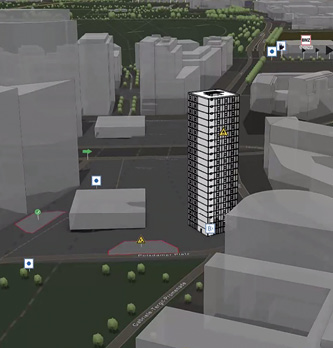
Three-dimensional digital twin assets, BIM, exist of nearly all contemporary buildings and can provide critical situational awareness of physical assets during first response operations. (Source: Figure courtesy of authors.)
Mixed reality combines the real world with virtual elements, creating an environment that blends physical and digital reality. Using mixed reality, firefighters and EMS personnel can visualize and interact with their surroundings in ways that previously were not possible. For example, they can use augmented reality headsets to overlay digital information onto the physical world, providing real-time data on the emergency.
Computational fluid dynamics (CFD) modeling is another emerging technology poised to transform emergency response. By simulating how smoke, heat, and people move through a building, CFD modeling can help firefighters and EMS personnel better understand the dynamics of fire propagation, flow paths, heat release rates, door control, and best firefighting strategy. This technology can also identify potential hazards such as areas of high heat or toxic gases (photo 3).

3. A partially submerged apparatus responding to a synthetic flooding rescue, a TechX event in collaboration with Futura.
Virtual worlds offer yet another potential use for digital twins in emergency response. Emergency responders can simulate different scenarios and practice their response in a safe, controlled environment by creating a virtual replica of a building or structure. This can be especially valuable for training new firefighters and EMS personnel, as it allows them to experience various emergency scenarios without putting themselves or others at risk. By combining digital twins with mixed reality, CFD modeling, and virtual worlds, the fire station of the future can become a highly advanced, efficient, and practical center of emergency response.
With real-time data, insights, and simulations, firefighters and EMS personnel can respond to emergencies more quickly and effectively while being better prepared to prevent and manage potential hazards. These technologies can also help emergency response organizations identify potential risks and improve operations, leading to safer emergency response services and enhanced economic impact (photo 4).
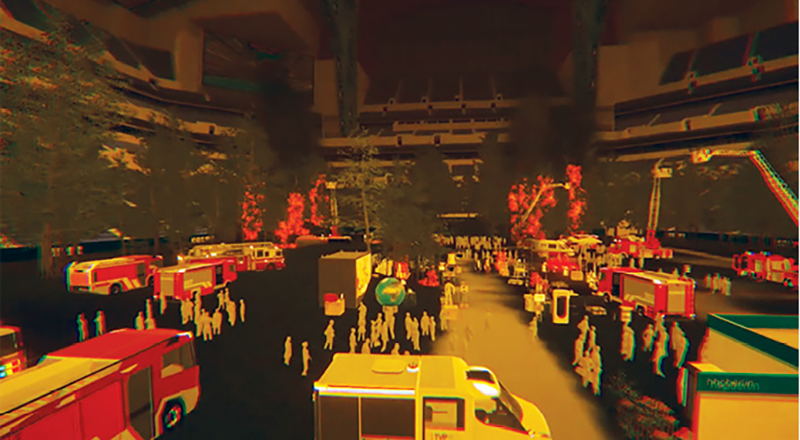
4. Industry leaders across the domain imagine a future state and how an active SMART FDIC experience could be crafted.
The world in VUCA mode will take special consideration for navigating ever-advancing digital transformation. There will be a rise of SMART cities and exploration of the emergence of intelligent urban centers. These advancements will be a paradigm shift and necessity for a fundamental change in our approach from reactive to proactive strategies. Like a public safety disc jockey, there is a need for the mixing desk of public safety, which provides a balanced volume control for the role of the public sector with responsibility for safety, security, and resilience.
A zero-approach paradigm shift enables agencies that consider departure from being a cost driver to becoming a production factor to strive for zero alarms and incidents with economic impact at scale (Figure 4). Some ask what is beyond a three-digit phone number in the bid for a NextGen Public Safety Authorities (PSA) operating system. In addition to FirstNet® in the United States, what are the international hardware and software stacks that will enable the development of the foundational framework for future public safety entities? Rather than a cost driver, PSAs could be part of the production factor and contributors to sustainable and secure SMART city development with a positive impact on regional, national, and global economies.
Figure 4. Paradigm Shift
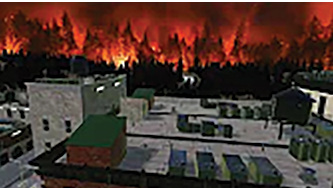
Industry leaders are considering how synthetic wildfire (and live integration in the world in 3D) will allow for the paradigm shift at trade shows like FDIC during public education and at the time of intervention across the public safety landscape. (Source: Figure courtesy of authors.)
The role of data-driven agencies has been emphasized in decision making for more than a decade, with public safety departments becoming active participants in the data ecosystem and agencies becoming subscribers to integrated data systems. The NextGen (NG) station is part of an evolving fire and rescue facility design that will act as intelligent connected SMART hubs with ethical and equitable machine learning (often called ML) and AI.
One component of the NG station (and the greater NG911 ecosystem) is the shift to the tactical vehicle platform concept. Advancements in connected apparatus for enhanced emergency response capabilities will see additional communication capabilities, including MCPTT, 4.9 GHz spectrum, and satellite communications. Greater connectivity and data transfer capabilities will enable high-speed computing at the edge with federal partners and innovators in the enterprise space. In partnership with Ford Motor Company and Microsoft, Darley is considered the pole-position provider, garnering significant press for its tech-enabled Bronco.
On a grander scale, advancing tech systems from enterprise teams, including Apple’s SOS watch features, 5G, resilient cities, and digitally enhanced societies, are preparing communities for resilience in the face of VUCA challenges. PSA will use portable demonstration laboratories that provide an immersive experience while exploring innovative ways to engage with emergency response concepts. However, as with any emerging technology, some challenges must be addressed to ensure technology is user-friendly and accessible across the massive emergency response ecosystem. Cybersecurity and data privacy must be carefully managed to secure sensitive information while protecting the public’s trust, with more than 700,000 calls to dispatch daily in the United States alone.
When aligned with the National Fallen Firefighters Foundation’s Everyone Goes Home Life Safety Initiatives, all technologies are critical. Initiative #8 states: “utilize available technology wherever it can produce higher levels of health and safety.” The use of digital twins, mixed reality, CFD modeling, and virtual worlds holds tremendous promise for the fire, rescue, and EMS industry of the future. These technologies can help emergency responders understand the dynamics of an emergency better, respond more quickly and effectively, and ultimately save more lives, protect more property, and positively impact the economy at scale.
As technology continues to evolve, the possibilities for the future fire station and apparatus within them are truly limitless, and it will be exciting to see how these technologies continue to develop and advance in the years to come. One thing is certain: Change is the only constant, and the impact on the evolving public safety paradigm shift is accelerating.
REFERENCES
“16 Firefighter Life Safety Initiatives, #8,” Everyone Goes Home, 2016. bit.ly/3UgutN1.
Ascent Integrated Tech (AIT). ascentitech.com.
Castillo, Andy, “4.9 GHz presents opportunity for public safety but requires the right management, IWCE speakers say,” IWCE’s Urgent Communications, April ٥, ٢٠٢٣. bit.ly/٣u٩٠iN٩.
“First Responder Network Authority Roadmap,” FirstNet Authority. ٢٠٢٣. bit.ly/٣u٨z٣Cr.
“First Responder Smart Tracking Challenge,” Trustees of Indiana University, 2024. frstchallenge.com.
Hamins, Anthony P., and Casey Grant, Nelson P. Bryner, Albert W. Jones, Galen H. Koepke, “Research Roadmap for Smart Firefighting,” NIST, June 2015. bit.ly/48Ks1CZ.
Hojlo, Jeffrey, “Future of Industry Ecosystems: Shared Data and Insights,” IDC, January 6, 2021. bit.ly/3St3T20.
“NIST Is Requesting Public Input on Published Strategic Plan for Smart Cities Program,” NIST, January 25, 2024. bit.ly/4bo9I8f.
“Search and Rescue + Wildfire,” TechXEvents, February 1, 2022. bit.ly/47VL7F6.
“TechX2022 Flooding Scenario,” Study Sonic Focus, September 4, 2023. bit.ly/3UagzvS.
Kirk McKinzie is a 35-year fire service veteran a retired captain from the Cosumnes (CA) Fire Department and a first responder technologist who functions as an SME, an advisor, a speaker, and an author to government, enterprise, academia, startups, and operators focused on emergency response digitization and innovation for safer and more secure SMART communities. His focus includes extended reality (XR) and AI-enabled lifesaving technological solutions.
Stefan Truthän has been a key pillar at hhpberlin since 2002 and has overseen its operational and strategic evolution since 2008. As a member of committees like the INTERSCHUTZ advisory board, he represents hhpberlin, setting innovative directions for public safety with his team. Beyond his professional role, he’s actively involved in volunteer work, notably with the Berlin Fire Department. His dedication and expertise position him as a central figure in pursuing a safer, future-oriented society.
Kirk McKinzie will present “Enhancing Fire-Rescue and EMS Operations with SMART Systems” at FDIC International in Indianapolis, Indiana, on Friday, April 19, 2024, 8:30 a.m.-10:15 a.m.

